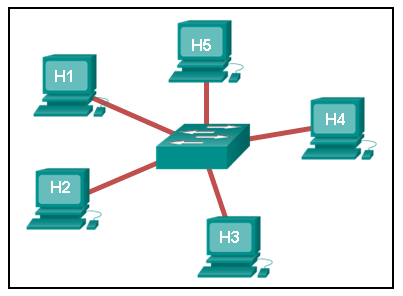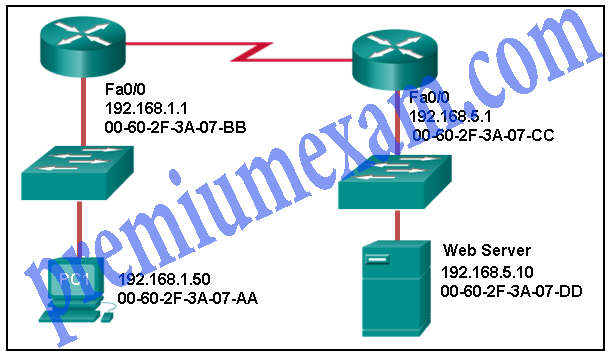Last Updated on January 28, 2021 by Admin
ITN Chapter 5 Quiz Answers Cisco 2019 100%
This quiz covers the content in CCNA R&S Introduction to Networks Chapter 5. It is designed to provide an additional opportunity to practice the skills and knowledge presented in the chapter and to prepare for the Chapter Exam.
-
Refer to the graphic. H2 has sent a broadcast message to all of the hosts. If host H1 wants to reply to the broadcast message, which statement is true?
- H1 sends a unicast message to H2, but the switch forwards it to all devices.
- H1 sends a unicast message to H2, and the switch forwards it directly to H2.
- H1 sends a broadcast message to H2, and the switch forwards it to all devices.
- H1 sends a multicast message to H2, and the switch forwards it directly to H2.
Explanation: Since H2 has just sent a broadcast message to all hosts, the MAC address for H2 is already in the switch MAC table. A unicast message from H1 to H2 will therefore be forwarded by the switch directly to H2.
-
What is the decimal equivalent of the hexadecimal value of 3F?
- 18
- 34
- 45
- 46
- 63
Explanation: In order to convert a hexadecimal number to decimal, consider that the digit to the far right represents the 1s column where values 0 through F can appear. A hexadecimal value of A equals the decimal number 10. B equals 11, and so on through F equaling 15. The value of F in the number F equals 15. Next consider the value of 3 in the hexadecimal number of 3F. That place holder is the 16s column. Multiple the number 3 times 16 for a total of 48. Add 48 to 15 for the grand total of 63. Hexadecimal 3F equals a decimal value of 63.
-
Fill in the blank using a number.
The minimum Ethernet frame size is 64 bytes. Anything smaller than that should be considered a “runt frame.”
Explanation: Ethernet II and IEEE 802.3 standards define the minimum frame as 64 bytes and the maximum as 1518 bytes. -
What is the primary purpose of ARP?
- translate URLs to IP addresses
- resolve IPv4 addresses to MAC addresses
- provide dynamic IP configuration to network devices
- convert internal private addresses to external public addresses
-
Refer to the exhibit. PC1 issues an ARP request because it needs to send a packet to PC3. In this scenario, what will happen next?
- RT1 will forward the ARP request to PC3.
- RT1 will send an ARP reply with its own Fa0/0 MAC address.
- RT1 will send an ARP reply with the PC3 MAC address.
- SW1 will send an ARP reply with its Fa0/1 MAC address.
- RT1 will send an ARP reply with its own Fa0/1 MAC address.
Explanation: When a network device has to communicate with a device on another network, it broadcasts an ARP request asking for the default gateway MAC address. The default gateway (RT1) unicasts an ARP reply with the Fa0/0 MAC address.
-
Which action is taken by a Layer 2 switch when it receives a Layer 2 broadcast frame?
- It drops the frame.
- It sends the frame to all ports except the port on which it received the frame.
- It sends the frame to all ports that are registered to forward broadcasts.
- It sends the frame to all ports.
Explanation: When a Layer 2 switch receives a frame with a broadcast destination address, it floods the frame to all ports except the port on which it received the frame.
-
Fill in the blank.
On Ethernet networks, the hexadecimal address FF-FF-FF-FF-FF-FF represents the broadcast MAC address.
- Noted: There are 3 possible answers. You can fill in one of the following in netacad: broadcast, Broadcast, BROADCAST. But you can fill only broadcast in our system.
Explanation: On Ethernet networks, the broadcast MAC address is 48 binary ones displayed as hexadecimal FF-FF-FF-FF-FF-FF.
- Noted: There are 3 possible answers. You can fill in one of the following in netacad: broadcast, Broadcast, BROADCAST. But you can fill only broadcast in our system.
-
When the store-and-forward method of switching is in use, what part of the Ethernet frame is used to perform an error check?
- CRC in the trailer
- source MAC address in the header
- destination MAC address in the header
- protocol type in the header
Explanation: The cyclic redundancy check (CRC) part of the trailer is used to determine if the frame has been modified during transit. If the integrity of the frame is verified, the frame is forwarded. If the integrity of the frame cannot be verified, then the frame is dropped.
-
Which two functions or operations are performed by the MAC sublayer? (Choose two.)
- It is responsible for Media Access Control.
- It performs the function of NIC driver software.
- It adds a header and trailer to form an OSI Layer 2 PDU.
- It handles communication between upper and lower layers.
- It adds control information to network protocol layer data.
Explanation: The MAC sublayer is the lower of the two data link sublayers and is closest to the physical layer. The two primary functions of the MAC sublayer are to encapsulate the data from the upper layer protocols and to control access to the media.
-
Fill in the blank.
The Ethernet MAC sublayer is responsible for communicating directly with the physical layer.
- Noted: There are 3 possible answers. You can fill in one of the following in netacad: MAC, Mac, mac. But you can fill only MAC in our system.
Explanation: Ethernet at the data link layer is divided into two sublayers – the MAC and the LLC sublayers. The LLC sublayer is responsible for communicating with the upper layers, and the MAC sublayer communicates directly with the physical layer.
- Noted: There are 3 possible answers. You can fill in one of the following in netacad: MAC, Mac, mac. But you can fill only MAC in our system.
-
Refer to the exhibit. What is the destination MAC address of the Ethernet frame as it leaves the web server if the final destination is PC1?
- 00-60-2F-3A-07-AA
- 00-60-2F-3A-07-BB
- 00-60-2F-3A-07-CC
- 00-60-2F-3A-07-DD
Explanation: The destination MAC address is used for local delivery of Ethernet frames. The MAC (Layer 2) address changes at each network segment along the path. As the frame leaves the web server, it will be delivered by using the MAC address of the default gateway.
-
Fill in the blank.
The binary number 0000 1010 can be expressed as 0A in hexadecimal.
- Noted: There are 6 possible answers. You can fill in one of the following in netacad: 0A, 0a, A, a, 0x0a, and 0x0A. But you can fill only 0A in our system.
Explanation: The binary number 0000 1010 can be expressed as 0A in hexadecimal.
- Noted: There are 6 possible answers. You can fill in one of the following in netacad: 0A, 0a, A, a, 0x0a, and 0x0A. But you can fill only 0A in our system.
-
A Layer 2 switch is used to switch incoming frames from a 1000BASE-T port to a port connected to a 100Base-T network. Which method of memory buffering would work best for this task?
- port-based buffering
- level 1 cache buffering
- shared memory buffering
- fixed configuration buffering
Explanation: With shared memory buffering, the number of frames stored in the buffer is restricted only by the of the entire memory buffer and not limited to a single port buffer. This permits larger frames to be transmitted with fewer dropped frames. This is important to asymmetric switching, which applies to this scenario, where frames are being exchanged between ports of different rates. With port-based memory buffering, frames are stored in queues that are linked to specific incoming and outgoing ports making it possible for a single frame to delay the transmission of all the frames in memory because of a busy destination port. Level 1 cache is memory used in a CPU. Fixed configuration refers to the port arrangement in switch hardware.
-
What type of address is 01-00-5E-0A-00-02?
- an address that reaches every host inside a local subnet
- an address that reaches one specific host
- an address that reaches every host in the network
- an address that reaches a specific group of hosts
Explanation: The multicast MAC address is a special value that begins with 01-00-5E in hexadecimal. It allows a source device to send a packet to a group of devices.
-
When a switch configuration includes a user-defined error threshold on a per-port basis, to which switching method will the switch revert when the error threshold is reached?
-
- fragment-free
-
- fast-forward
- cut-through
- store-and-forward
Explanation: When the store-and-forward switching method is used, the switch receives the complete frame before forwarding it on to the destination. In contrast, a cut-through switch forwards the frame once the destination Layer 2 address is read.
-


